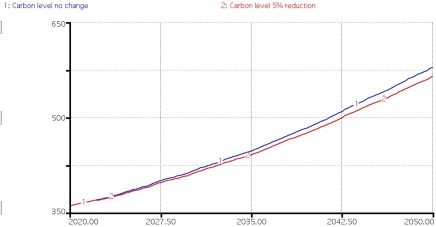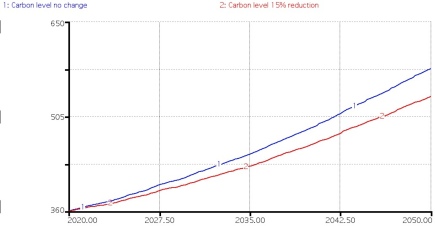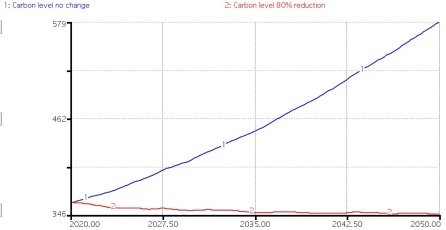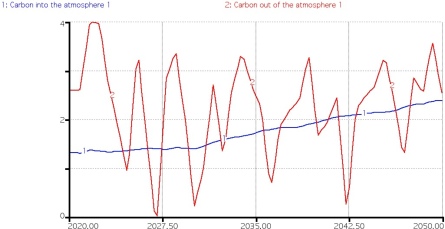The UN Intergovernmental Panel on Climate Change has warned of an increase in severe and irreversible damage to the planet if high greenhouse gas emissions continue and the planet warms significantly.
What follows here is an explanation of the total inadequacy of the targets being set particularly those set in Australia. The explanation is built on a very simple little model and the data is taken from the Pro-Oxygenwebsite.
The technical term for this diagram is a stock-flow-rate diagram. It’s a bit like a bathtub (which is the stock which acts as an accumulation), the inflow of carbon dioxide is like a tap running into the bathtub. The carbon absorbed by land sinks (that is forests) is like a plughole, draining the carbon dioxide out of the atmosphere. The bath tub is currently filling up at a frightening rate.
This is because we are emitting more carbon dioxide than the land sinks can absorb. What is not absolved is stored in the atmosphere and in the oceans.
Here’s a graph that illustrates the problem.
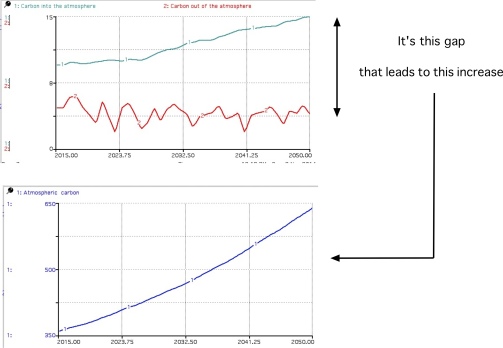
This graph shows the gap between what is being emitted and what is being absorbed. This amount is the amount that is pumped into the atmosphere every year. While the absorption is patchy it is relatively consistent while the emissions continue to rise.
Politicians and the media focus on the amount that we have to reduce the amount of emissions. But this is not what we must be concerned about. It is the total accumulation of carbon dioxide in the atmosphere that is going to destroy the environment.
The trick to solving the climate change problem is to get the amount we are emitting below the capacity of the land sinks to absorb CO2. It is not until we have done this that the total amount of CO2 in the atmosphere will begin to decline.
Australia currently has a goal of reducing carbon emissions by 5% by 2020. It is unclear what the goal will be beyond that. But here’s a picture of what reducing CO2 emissions global by 5% in 2020 will do.
Compared with the “no action” scenario, there is a slight but almost imperceptible change in the total accumulation of CO2.
There is talk of setting a target of 15% by 2020. The following graph shows the impact of this target.
As you can see, we are still not making any progress. Atmospheric carbon levels are still rising which really makes the debate about a target of 5% or 15% pretty much irrelevant.
So what is it going to take to deal with this problem. The next graph shows a reduction of 40% from 2020. This is the level suggested by a recent conference of scientists in Europe.
For simplicity’s sake, and to demonstrate the magnitude of the change required, I’ve shown the effect of all at once. A more realistic approach would be to achieve this target over a number of years, but it would still need to be a total of an 80% reduction whatever time period is used.
It has been possible to achieve this result because the level of carbon emission is down to level that can be absorbed.
This level of reduction will maintain total CO2 in the atmosphere at current levels. A level that the UN Intergovernmental Panel on Climate Change says will include more coral bleaching of the Great Barrier Reef; declines in rainfall in southern NSW and Victoria and a 20-40% increase in Melbourne days over 35 degrees by 2035.
Clearly, we are not getting a 80% reduction in emissions starting in 2014 but this does illustrate the magnitude and seriousness of the problem and certainly that the 5% target by 2020 will be woefully inadequate.
The other approach to the problem is to increase the capability of the land sinks to absorb CO2. The following graph shows the impact of an immediate 20% increase in the Earth’s ability to absorb CO2 namely, a 20% increase in total global forestation.Again, this is shown happening immediately but clearly a 20% increase in global forestation will take a millennia, time we might not have.
This does not have as great an impact as cutting emissions but under the combined scenarios total CO2 in the atmosphere is finally declining. To achieve this we must have an 80% reduction in emissions starting in 2014 and at 20% increase in forestation, also starting in 2014.
Yes, the problem is that serious and that intractable.
But not if you’re a Prime Minister whose views of climate change seem to be based on some doggerel that was written by a 22-year-old member of the landed gentry at the beginning of the last century.
Dorothea Mackellar loved a sunburnt country and as far as Tony Abbott is concerned things haven’t changed much since she wrote My Country.

Tony Abbott’s climate adviser Dorothea Mackellar
‘Australia’s a land of droughts and flooding rains, always has been, always will be,’ said Abbott in a comment that would be laughable if it were not so tragic.

